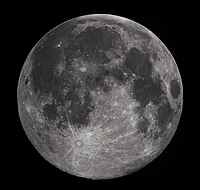MOON
| Diameter | 3,474.8 km |
| Mass | 7.349×1022 kg |
| Semi-major axis | 384,400 km |
| Orbital period | 27 d 7 h 43.7 m |
The Moon is a relatively large, terrestrial, planet-like natural satellite, with a diameter about one-quarter of Earth's. It is the largest moon in the Solar System relative to the size of its planet, although Charon is larger relative to the dwarf planet Pluto. The natural satellites of other planets are also referred to as "moons", after Earth's.
The gravitational attraction between Earth and the Moon causes tides on Earth. The same effect on the Moon has led to its tidal locking: its rotation period is the same as the time it takes to orbit Earth. As a result, it always presents the same face to the planet. As the Moon orbits Earth, different parts of its face are illuminated by the Sun, leading to the lunar phases; the dark part of the face is separated from the light part by the solar terminator.
Due to their tidal interaction, the Moon recedes from Earth at the rate of approximately 38 mm/yr. Over millions of years, these tiny modifications—and the lengthening of Earth's day by about 23 µs/yr—add up to significant changes. During the Devonian period, for example, (approximately 410 mya) there were 400 days in a year, with each day lasting 21.8 hours.
The Moon may have dramatically affected the development of life by moderating the planet's climate. Paleontological evidence and computer simulations show that Earth's axial tilt is stabilized by tidal interactions with the Moon. Some theorists think that without this stabilization against thetorques applied by the Sun and planets to Earth's equatorial bulge, the rotational axis might be chaotically unstable, exhibiting chaotic changes over millions of years, as appears to be the case for Mars.
Viewed from Earth, the Moon is just far enough away to have almost the same apparent-sized disk as the Sun. The angular size (or solid angle) of these two bodies match because, although the Sun's diameter is about 400 times as large as the Moon's, it is also 400 times more distant. This allows total and annular solar eclipses to occur on Earth.
The most widely accepted theory of the Moon's origin, the giant-impact hypothesis, states that it formed from the collision of a Mars-size proton planet called Thea with the early Earth. This hypothesis explains (among other things) the Moon's relative lack of iron and volatile elements and the fact that its composition is nearly identical to that of Earth's crust.



No comments:
Post a Comment